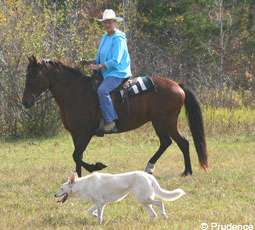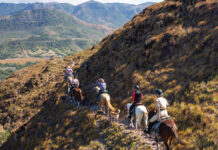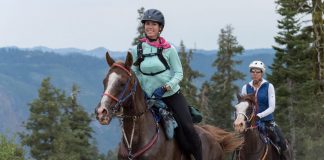
Growing up, I spent most of my summer days riding in our pasture, often accompanied by Sugar and Ranger, our two German Shepherds. Sometimes the boy next door would join us, and on one such occasion we came across some of his family’s cattle that had strayed through a break in the fence. We rode toward them to herd them back home. Sugar and Ranger’s herding instincts kicked in, and they helped round them up.
Ride-along Requirements
The qualities a dog needs are physical and mental soundness, a calm and quiet demeanor around livestock, and the ability to respond to commands from an owner on horseback. Also take into account the dog’s personality. Some dogs are more dependent than others on being with people. They never run ahead to follow a scent or chase a rabbit. This type of dog is easy to ride with, although that’s not to say you can’t train a more independent-minded dog to be your trail companion.
A horse should be calm enough not to spook at the sight of a dog appearing out of brush or tall grass and shouldn’t be a kicker, for the safety of a dog following along behind it. Consider your horse’s experience level as well as your relationship with him. Does he have a sensible attitude? Is he easily controlled? Has he encountered a variety of different situations and reacted with little or no spooking? Are the two of you in tune with each other?
Before horse and dog encounter each other, your dog should readily respond to the commands sit, down, stay and come. Voice control is a must; you shouldn’t have to repeat commands before the dog obeys, and he should be trustworthy off leash. Take him to an obedience class and work with him frequently at home until he’s letter-perfect. Then he’s ready to accompany you to the barn while you’re doing chores.
Types of Dogs
The herding breeds are smart and easy to train, and being around large animals is part of their heritage. The important thing is to make sure they don’t try to herd the horses, unless that is what you ask. For instance, some horse owners use dogs to herd horses into trailers.Sporting breeds such as retrievers and pointers are often used for hunting on horseback. They too are intelligent and easily trained and make excellent riding companions.Hounds are more independent and may range out on their own, but they have a lot of stamina. They generally have a laid-back temperament that makes them good around horses. A sight hound will enjoy the opportunity to stretch his legs and gallop along with the horse—at least for a while.
Like the herding and sporting dogs, working breeds such as Doberman Pinschers and Standard or Giant Schnauzers take well to training and have the temperament to get along with horses.
Among the non-sporting dogs are Dalmatians, the gold standard horse dog. The Dalmatian’s history as a coach and firehouse dog give him a longstanding affiliation with horses, and the Dalmatian Club of America even offers road work titles that test the dog’s ability to trot alongside horses for long distances. Other non-sporting breeds that might do well around horses are Miniature and Standard Poodles.
Terriers are high-energy dogs and aren’t the easiest to train. Nonetheless, Fox Terriers and Jack Russell Terriers are frequently found in the company of horses and can make good riding companions.
Even toy breeds have been known to fare well around horses. Cavalier King Charles Spaniels are often associated with horses, and one rider reports that her Pekingese often goes trail riding with her. (If the dog get tired, it rides in her lap.)
Good Dogs
Remind your dog not to get too close and to stay out from underfoot—yours and the horse’s. The time together also allows your horse to get used to the dog. This is a good time to start teaching the command get out—used in herding—which tells the dog to move out farther and wider. This command will come in handy on rides when the dog gets too close. Another useful command is down, which your dog should be willing to perform even at a distance. You may need to use it if the dog is heading toward something dangerous or if you simply want him to wait until you catch up. Work with a dog trainer or herding expert to teach these commands.
The next step is to practice obedience exercises in a pasture or other safe area. The practice sessions will help your dog feel comfortable being so close to the horse and will accustom the horse to watching out for the dog so he doesn’t step on him. Teach the dog to sit on leash while you mount and not to cross in front of the horse when he’s moving. If you live or ride in an area where it’s not safe to let the dog off leash, use a long lead or a longe line and teach the dog to stay on your left.
Safety is Serious
Take some precautions to ensure the well-being of both of your animals. These safety measures include making sure the line is long enough so the horse doesn’t step on the dog, and anticipating situations that could spook or excite the animals and cause dog and horse to become entangled. Encounters with livestock—especially if you’re riding with a herding dog—other dogs or wildlife are all potentially spooky situations. Naturally, you can’t predict when such things will occur, but you should have a plan in mind so you can react quickly. Practice telling your dog to sit or down unexpectedly, so that he learns to respond instantly. Ranchers may have no compunction about shooting dogs that harass livestock, so your dog’s willingness to follow orders can mean the difference between life and death.
Even if you’re comfortable letting your dog accompany you off leash (preferably in an off-road area), you’ll still want to be able to keep track of him, especially if you’re riding in high grass or if your dog likes to explore on his own. Attach a small cowbell to the dog’s collar, and you’ll be able to hear him from a distance. Call him back regularly so you know he’s all right. Returning to your signal is good practice for him, and it’s just good sense to have a dog that comes when you call, no matter what.
Under most circumstances, dogs can accompany horse and rider without any problems. Injuries or even the dog’s death can occur, though, if the situation gets out of hand. Veterinarian Deb Eldredge of Burrstone Animal Hospital in New Hartford, New York, has seen dogs die or suffer fractured skulls, broken ribs or legs after a kick from a horse. “Almost always this is a dog ‘worrying’ the horse,” she says. Her advice? Don’t let your dog around horses except in controlled situations. Even a trained dog can make mistakes and may not recognize an unfriendly horse or an unsafe situation. This is especially important around busy boarding and riding facilities, for the safety of your dog as well as other horses and riders. Always know where your dog is and don’t allow him to become a danger to himself and others.
Nonetheless, the pleasures of riding with a dog far outweigh the risks. Eldredge says, “When I look back over my life so far, some of the best moments were out riding on a gorgeous day with my horse Trouble and my dog Cyrus: being out in nature with man’s two best friends.”
Read other articles about Dogs and Horses >>






I have a Dalmatian and never realized that they were “horse” dogs. Thanks for the information and I really enjoyed your article.
My Springer Spaniel and lab mix go on all my trail rides. My horse enjoys their company and worries when he can’t see them (they often run after unseen things in the woods!). I can feel my horse relax when the dogs come running back. Both dogs are well behaved and stay away from the horse’s legs.
Thanks for the info!
Nice write up. My Standard Schnauzer goes out with me and my gelding thoroughbred. We are still on lead, but working towards off lead. I would enjoy more articles about this subject.
great artical I am buying a dog and am expecting a horse a little later this artical realy helped
Sounds like fun! I want to train dogs, as well as horses, so this was pretty interesting to read!
I love riding with a dog at my side. Just I ride with a border collie, and she’s great with the horses. Just make sure horse and dog know each other well and that the dog obeys your commands without hesitation when on the trail and you’ll have a marvellous time.
Leigh-Ann
http://theultimatehorse.blogspot.com/
I understand that horses need to be used to all different types of animals ..especially if they’re trail horses…but, today while out on a trail in a public trail where it states that all dogs need to be on a leash I wasn’t expecting this to happen. Ofcourse, I ‘m constantly observing my horse’s behaviour to surroundings and I know that if there’s something to be alerted to she will be the first to hear it. But, we were coming around this corner and 2 black shepherds starting running towards us. Our horses turned and bolted. I was with a friend and this was probably around the 10th time we’ve been out on these trails. My horse isn’t usually a bolter and she was in a very relaxed headset before she saw those 2 unfamiliar dogs coming towards us. Horses will be horses and they took ‘flight’. My mare has had extensive groundwork done ..we work on it regularly and desensitized to tarps, bags, cans, whips, ropes, bridges, ect. There are 5 dogs at the barn that both the horses are very used to and not spooky with in the least. Really ,what else could be done that I prevent this happening again. ???